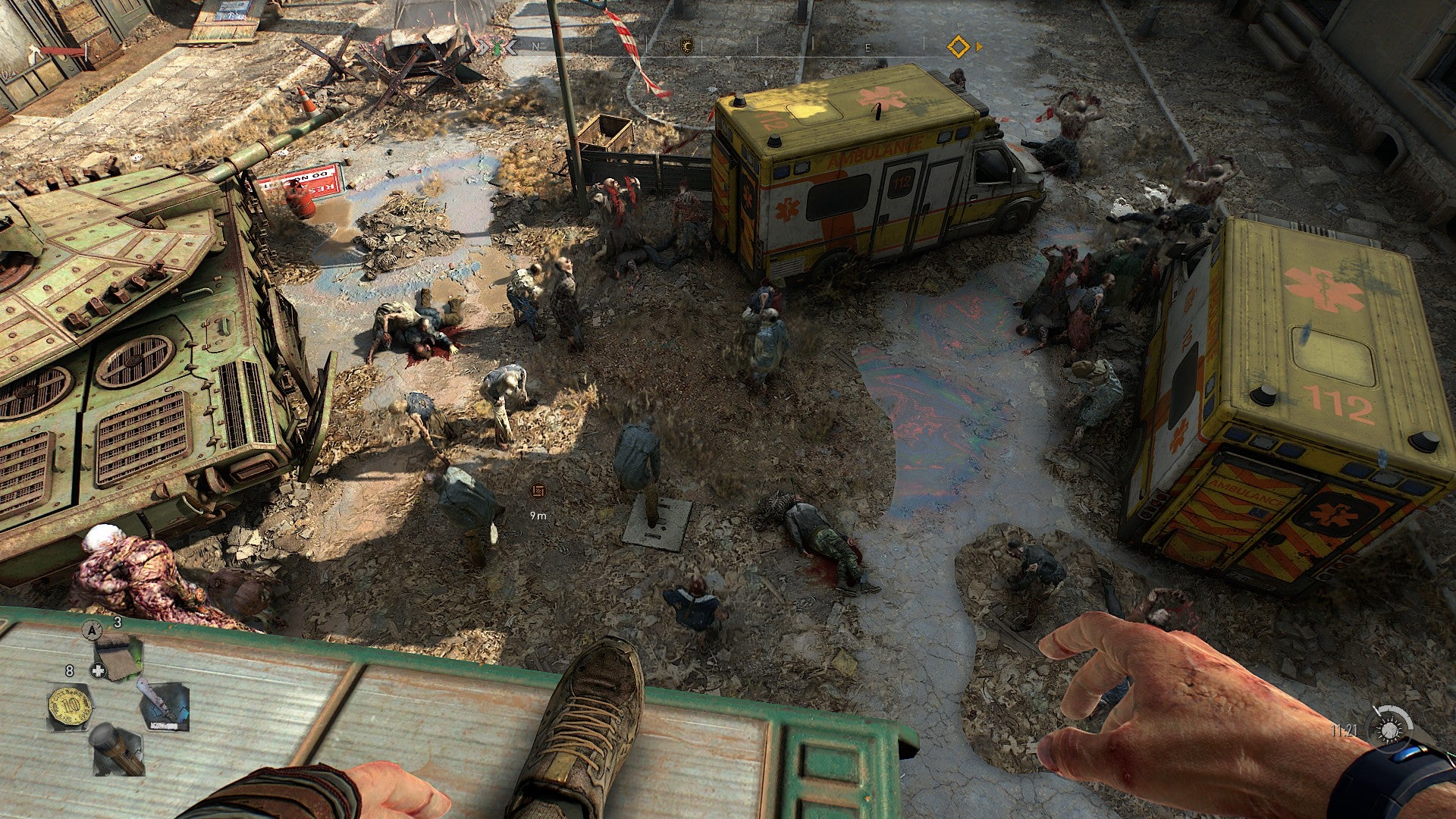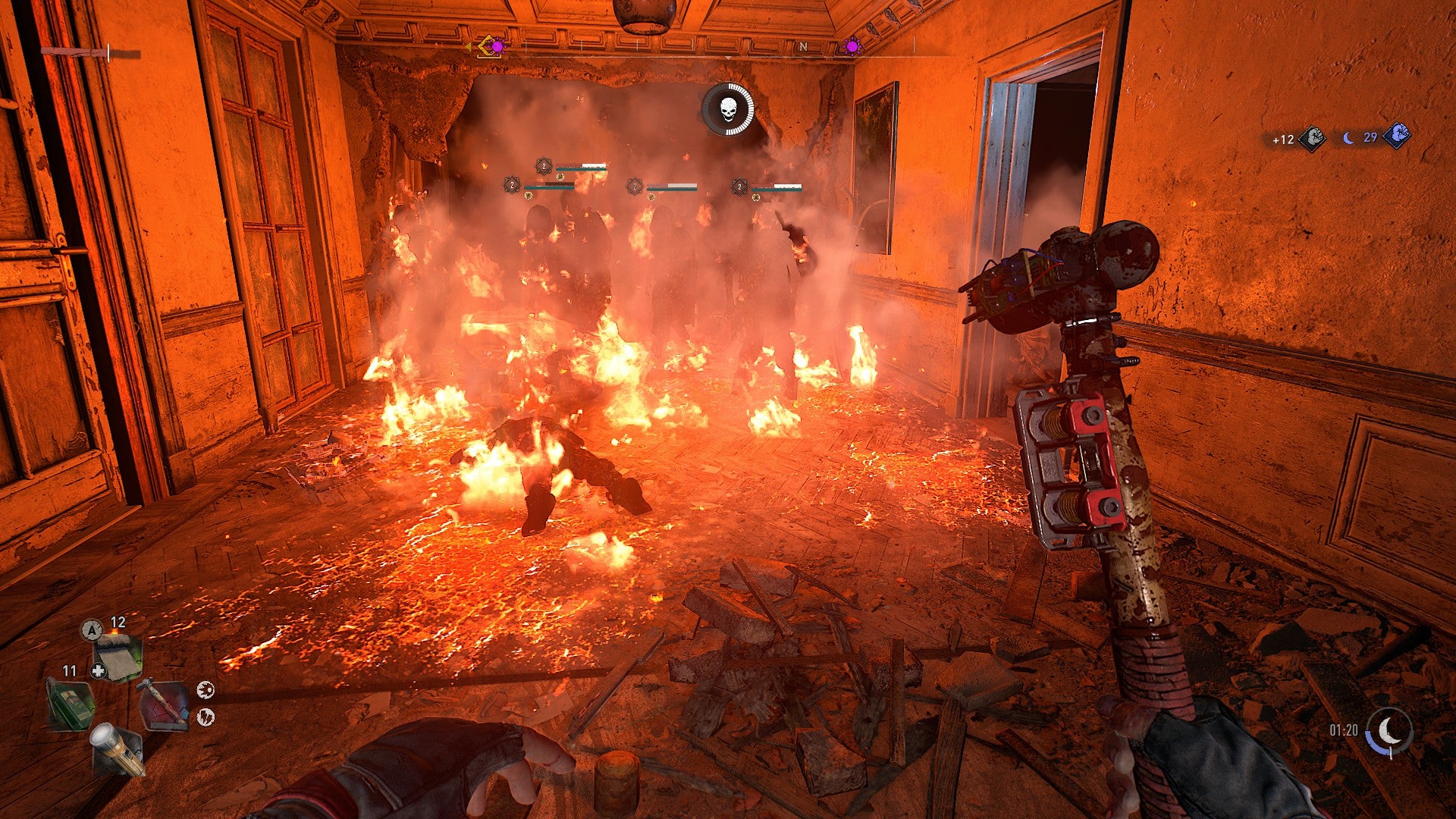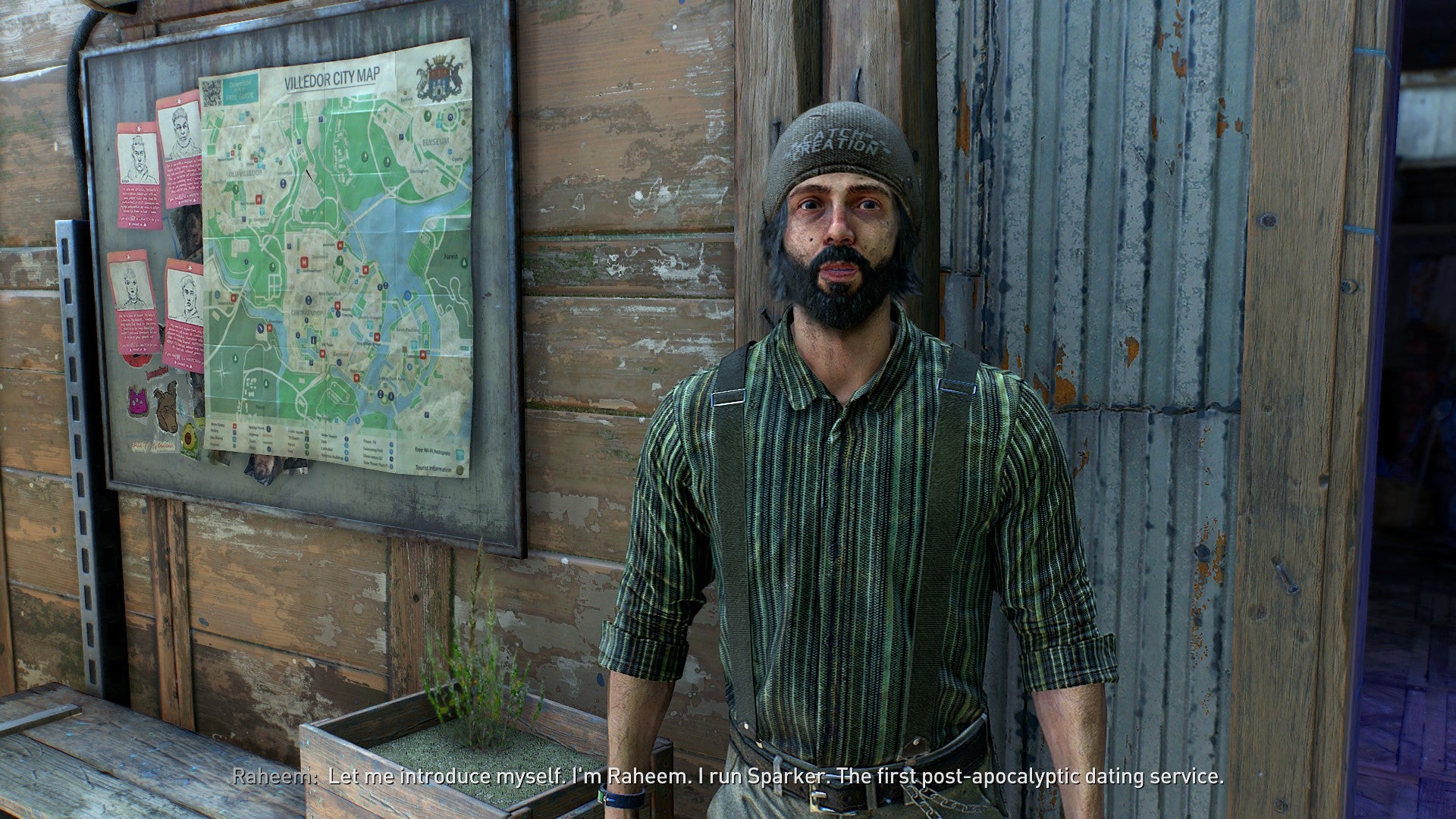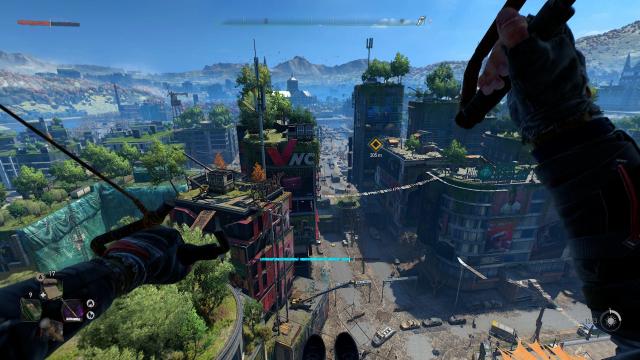The idea of being excited about yet another zombie video game in this, the year of our lord two-thousand and twenty-two, might seem ridiculous to some. Even I, a die-hard fan of the undead, understand how tired people are of zombies. They really are everywhere, from Back 4 Blood to Project Zomboid. But Dying Light 2 isn’t just another zombie game–a category that takes many forms, but rarely makes the act of moving around in the world exhilarating. Here, I’m reminded of games like Spider-Man and Crackdown, in which simply getting around the open world is as enjoyable as anything else they have to offer. And while it tries and fails to make its complicated branching narrative compelling, Dying Light 2 is still a game that I could see myself sinking 500 hours into, because the running, jumping, and undead-kicking is just so damn good and satisfying.
Developed by Techland, Dying Light 2 is an open-world first-person action-platformer with RPG elements and a whole lotta zombies to kill. It’s the follow-up to 2015’s Dying Light, though you don’t really need to have played that game to get what’s going on in this sequel.
In the first game, a horrible disease led to people dying and coming back as mutated, deadly zombies. In the years since then, that disease has spread to most of the world, and now communities are isolated and dependent on pilgrims–people who run from place to place through the harsh, zombie-filled world, delivering messages and supplies. You play as Aiden, one of these pilgrims, who has a strange past involving experiments and the undead. As a kid, Aiden and his sister were unwilling test subjects for horrible experiments. Aiden eventually escaped, but his sister Mia didn’t. Now, Aiden finds himself in the last large city on Earth, Villedor, on the hunt for Mia and the man responsible for the terrible tests.
This main narrative thread works fine as a way to propel Aiden through all the nonsense and violence found in Villedor, but it never really evolves into anything meaningful, mainly because the game spins its wheels for so long before it actually starts to reveal anything about Mia’s fate, or that of anyone else involved. By the end, I wasn’t even sure what the main villain wanted, which does not make for a very involving conflict or satisfying resolution. I won’t spoil anything here, but if you prefer games with well-written and cohesive narratives, Dying Light 2 ain’t that.
So, what is Dying Light 2? Well, it’s a giant, beautiful sandbox filled with zombies that you get to explore using some of the best traversal gameplay I’ve experienced. As a pilgrim, Aiden is very good at running, jumping, sliding, and climbing. And nearly every inch of the game’s large open world is covered in things to grab, climb, swing off of, and land on. The first game had similar parkour controls and level design, but Dying Light 2 feels as if Techland realised how the first game’s movement made it stand out from so many other zombie games, and focused on building it up more. The end result is one of the best parkour systems I’ve ever seen in a game.
When I encountered barriers in Dying Light 2, I would get excited, enjoying the process of scanning nearby walls and buildings for ways to get up and over the obstacle in my path. A tall wall with no obvious way to surmount it? No problem. I just wall run a bit, leap to and grab a nearby light post, spin off of that, land on a balcony of a shorter building across the street, then sprint and leap across the road back toward the top of that first tall wall, overcoming it and feeling like a champion in the process. All of this takes just a few seconds, is silky smooth and feels amazing.
And you get to repeat this process hundreds of times, often facing new obstacles and having to come up with parkour solutions on the fly. Add in some hungry zombies and these moments quickly become not just satisfying environmental puzzles, but tense moments of survival. Plus, unlike the climbing in so many other games that make it difficult or impossible for you to fall or fail, here you can and will screw up. The fact that missing a landing or not thinking ahead enough could lead to danger or death makes the parkour all the more tense and thrilling.

As you level up and unlock more parkour moves (as well as naturally get better with the controls over time), you quickly build up a large library of techniques that can be combined into long chains that elegantly flow together. I rarely fast-travelled in Dying Light 2 because, like Spider-Man on PS4, moving around the city is way too much fun to just warp to the next quest.
Eventually, Dying Light 2 does give you access to a paraglider and grappling hook, but these don’t detract from the fun of parkouring (is that a word?) around the city. Instead, they elevate that part of the game. Now you can paraglide up to the very top of skyscrapers in a few seconds, then use your parkour skills and grappling hook to swing and jump around inside and outside the structure searching for collectibles. I say this with no exaggeration: Moving around this world is some of the most fun I’ve had in a game in some time.
Of course, it’s not all running and jumping in Dying Light 2. There are also zombies and humans to kill. But while Dying Light 2 is presented in a first-person perspective, this isn’t an FPS. As far as I can tell after nearly 45 hours of playtime, there appear to be no guns in Dying Light 2. There are some bows and crossbows, but firearms seem nowhere to be found. (This is explained in some of the game’s lore, if you care about that kind of thing.) This isn’t surprising considering how rare guns were in the first game and how bad they felt to use once you got them. Leaving them out of the equation was the right call, and Techland has instead focused combat around close-quarters melee action.
[review heading=”Dying Light 2″ image=”https://www.kotaku.com.au/wp-content/uploads/sites/3/2022/02/03/68ccf25ad23de9eecfd0552681d7c076.jpg” label1=”BACK OF THE BOX QUOTE” description1=”“Parkour! Parkour! Parkour!”” label2=”TYPE OF GAME” description2=”Zombie infested first-person open-world parkour/action RPG ” label3=”LIKED” description3=”Great movement controls, satisfying combat, gorgeous visuals, meaningful day/night cycle” label4=”DISLIKED” description4=”Crafting system is a chore, main quest is a dud, some filler content, complex controls” label5=”DEVELOPER” description5=”Techland” label6=”PLATFORMS” description6=”PS5, PS4, Xbox Series X/S, Xbox One, PC (Played)” label7=”RELEASE DATE” description7=”February 4, 2022″ label8=”PLAYED” description8=”Played about 45 hours alone. Completed the main questline, maxed out character skills, crafted dozens of weapons, and finished a large chunk of the game’s side content and quests.” ]
If you’ve ever played a first-person action game with melee combat, you’ll get the basics right away. Swinging, blocking, and dodging are your fundamentals, each mapped to a different button. But as you unlock better skills and find new weapons, the combat evolves into something much better than Skyrim with zombies.
Combat in Dying Light 2 feels both heavy and responsive. You can quickly swing away with a small pipe or use bigger weapons, like two-handed hammers, to slowly do damage in larger, heftier swings. But all of the combat feels tight. There isn’t that sense of floatiness that so many other first-person games with melee combat suffer from. This is thanks to how you subtly and automatically lock on to enemies as you attack them, while never being directly connected to any one specific bad guy or zombie during a fight. It leads to combat scenarios in which you’re diving around enemies, getting in a few good whacks, and then hopping over someone nearby to escape a follow-up attack. A ballet of blood, if you will. Some might find the controls for all of this too complex, but I found that with a few hours of practice, I was a smooth murder machine.

Contributing to the excitement of combat is your ability to modify weapons, adding extra blades to deal more damage, or electric batteries to shock and stun foes during critical hits. Unfortunately, the crafting and blueprint system in Dying Light 2 is a grind, requiring far too many resources to fully upgrade any of your weapons. Still, even a barely upgraded electric ax covered in flames is deadly and fun to use.
Like the original game, Dying Light 2 features a day/night cycle. And also like the last game, Dying Light 2 depicts night as a more dangerous time to go out. However, in the original, the threat of night was largely empty because you had plenty of resources and could easily defeat the tougher enemies that spawned at night. In the sequel, Techland better succeeds at making night feel harrowing. The streets become covered with zombies, and that includes all the nasty special infected variants that have become mandatory in any modern zombie game. Yes, there is a zombie in Dying Light 2 that spits, another one that blows up, and a huge, hulking one that moves slowly but packs a real punch if it catches you. But at night, there are so many zombies around that alerting just one of them leads to a frantic situation where fast-moving zombies, who co-exist alongside the more traditional walkers in this universe, relentlessly chase you until you die or find a safe place to hide.
Of course, there are rewards for those who venture out into the night, including better loot, fewer zombies in buildings, and the ability to earn XP at a faster rate. Eventually, by around the 30-hour mark or so, I felt powerful enough to handle most of what the night threw at me, but before that, it was a scary experience. Even after I grew stronger and had better weapons, I still found myself being more cautious at night, with the contrast between night and day almost making it feel like I was playing two different, but equally fun open-world zombie games.
In the lead-up to Dying Light 2’s release, Techland talked a lot about how the game’s story and its world would react to your decisions. But based on the fact that this review is nearing the end and I still haven’t talked much about any of that, you can probably guess that this isn’t really the case. While there are big decisions to make, like who gets the water supply or control of electricity in a certain area, the ramifications of these choices are small. Sure, I screwed over the quasi-military Peacekeepers faction multiple times, outright lying to them a few times even, and worse. But they still let me hang out with them. I could still do quests for them and freely visit their faction bases and trade with them. The only major thing that seemed to change based on my decisions was whether the city was filled with traps or parkour tools. That and which minor, mostly mundane fetch quests were available to me. It’s a shame, because when I first played the game in a preview event last year, I was excited by the idea of a large open world reacting to my choices. Unfortunately, the end result is barely worth mentioning alongside other features.

Instead, the best character and story moments happen outside of the main narrative and the big decisions you make. Dying Light 2 has some great side quests. One standout involves a man trying to set up a dating service for survivors using cards and bulletin boards. Another had me helping someone create a perfume that reminded them of the old world. (It turned out to be New Car Smell, funnily enough.) Some of these small quests even feature their own choices, like having to decide whether to help someone escape the city, at the cost of their loved one losing them forever. While none of these choices have larger consequences on how the story plays out, they stuck with me, unlike the bigger, more heavily promoted choices Techland wanted me to care about.
Dying Light 2 doesn’t tell a great or original zombie story, and it features a lot of big choices that mostly amount to nothing. But that’s fine, because where Dying Light 2 succeeds is in the smaller moments between the big ones. A fight against a horde of undead that you hadn’t planned on and might not survive. Escaping a tough enemy using all the parkour moves at your disposal. Barely surviving a nighttime excursion gone wrong and breaking your last good sword in the process. Or just swinging around, looking for the next place to explore but getting too distracted by how much fun it is to move around this place that you just…don’t stop.
Maybe the world doesn’t need another zombie game in 2022, but I’m happy we got one, and I’m happy it’s the wickedly fun sandbox of Dying Light 2.

Leave a Reply